

2015 Healthcare vision Mexico. A disruptive, recent arrival to a market or industry. These may include companies whose core businesses reside entirely outside of the new industry, or businesses expanding into new role. 1 hwang christensen healthcare. Ten Top Technologies That Will Transform The Healthcare Industry. Disrupting The Hospital Business Model. The distrustful consumer: Emerging trends: Healthcare: Industries: PwC. Consumer skepticism is fuelling a rise in DIY and non-traditional care services.
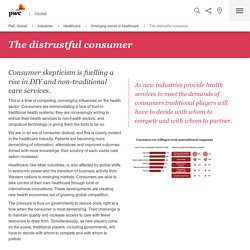
This is a time of competing, converging influences on the health sector: Consumers are demonstrating a lack of trust in traditional health systems; they are increasingly willing to entrust their health services to non-health sectors; and ubiquitous technology is giving them the tools to do so. We are in an era of consumer distrust, and this is clearly evident in the healthcare industry.
Patients are becoming more demanding of information, alternatives and improved outcomes. Armed with more knowledge, their scrutiny of each viable care option increases. Healthcare, like other industries, is also affected by global shifts in economic power and the transition of business activity from Western nations to emerging markets. The pressure is thus on governments to reduce costs right at a time when the consumer is most demanding.
Fee-For-Value Drives Trillion-Dollar Healthcare Opportunity. One of the main tenets of healthcare reform has been to better align payment/reimbursement schemes to incentivize healthcare providers for achieving improved outcomes and lower cost.
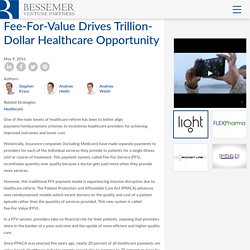
Historically, insurance companies (including Medicare) have made separate payments to providers for each of the individual services they provide to patients for a single illness, visit or course of treatment. This payment system, called Fee-For-Service (FFS), incentivizes quantity over quality because a doctor gets paid more when they provide more services. However, this traditional FFS payment model is experiencing massive disruption due to healthcare reform. The Patient Protection and Affordable Care Act (PPACA) advances new reimbursement models which incent doctors on the quality and cost of a patient episode rather than the quantity of services provided. The role of big data in medicine. Technology is revolutionizing our understanding and treatment of disease, says the founding director of the Icahn Institute for Genomics and Multiscale Biology at New York’s Mount Sinai Health System.

Most companies make a conscious and deliberate decision to embrace digitization and the information revolution. Yet the role of big data in medicine seems almost to compel organizations to become involved. In this interview, Dr. How healthcare systems can become digital-health leaders. The potential of digitization is well understood, yet healthcare systems are struggling to convert ambition into reality.
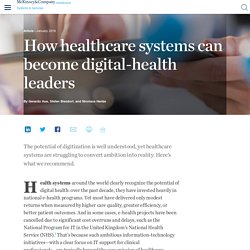
Here’s what we recommend. Health systems around the world clearly recognize the potential of digital health: over the past decade, they have invested heavily in national e-health programs. Yet most have delivered only modest returns when measured by higher care quality, greater efficiency, or better patient outcomes. And in some cases, e-health projects have been cancelled due to significant cost overruns and delays, such as the National Program for IT in the United Kingdom’s National Health Service (NHS). 17 Amazing Healthcare Technology Advances of 2017. The referralMD Annual 2017 Healthcare Technology Review is here:New year resolutions have been set with the goal of improving the future of healthcare with medical and dental technology advances.
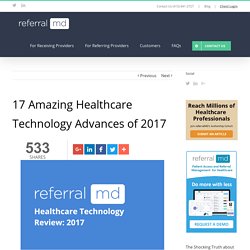
Will health systems accelerate the adoption of amazing technologies from the digital health startup community? Will we see new new drugs that cure major diseases? Will regulatory changes from the new Trump administration help or hurt? U.S. health care spending grew 5.8 percent in 2015, reaching $3.2 trillion or $9,990 per person. As a share of the nation’s Gross Domestic Product, health spending accounted for 17.8 percent. Trends in Industrie 40. Middle east industry 4 0 survey. Med e Tel 2013 Proceedings CD. KM landscape. Business Value from the Analytics of Things. Text mining techniques for patent analysis. FORECASTING. By Jack Yurkiewicz Here is an easy forecast to make: Forecasting will be part of our information flow for the foreseeable future.

OK, ignoring that clichéd or clever lead (pick one), I wanted to introduce our biennial forecasting software survey with a worthwhile and true example. Forecasting is a key topic in my Decision Modeling for Management course. Analytics Maturity Model San Francisco. Unique Model Provides Important Insights into Business and Helps Users Develop a Plan and Timeline for Reaching a Higher Level of Analytics Maturity SAN FRANCISCO, CA, November 11, 2014 – The Institute for Operations Research and the Management Sciences (INFORMS®) – the largest professional society in the world for professionals in the fields of analytics, operations research (O.R.) and management science – today announced the official launch of a unique new Analytics Maturity Model that is designed to help organizations of all sizes scrutinize the way they use analytics across the business and determine how to improve their best practices over time.
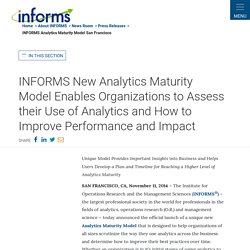
A Data Mining Primer for the Data Warehouse Professional. The key to data mining is ensuring that you have a foundation of quality data that is clean, consistent, and accurate.
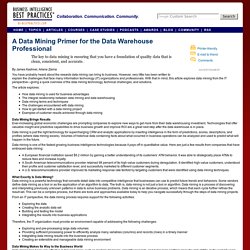
By James Kashner, Arlene Zaima You have probably heard about the rewards data mining can bring to business. However, very little has been written to explain the challenges that face many information technology (IT) organizations and professionals. Defining analytics: a conceptual framework. By Robert Rose Image © David Castillo Dominici | 123rf.com Arguably, the term “analytics,” as it is widely used today, was introduced in a research report “Competing on Analytics” [1] by Tom Davenport et al. in May 2005, and its emergence into public view coincided with the introduction of Google Analytics on Nov. 14, 2005.
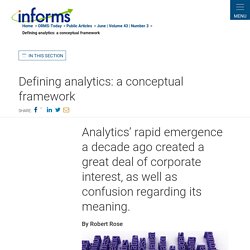
As can be seen in the Google Trends chart shown in Figure 1, in November 2005 searches for the term “analytics” jumped almost 500 percent. How Governments Can Engage Big Data Tech Tools for the Public Good - Industry... The effectiveness and legitimacy of government today is best demonstrated by its ability to deliver public services and accurate information to citizens when its citizens need it.
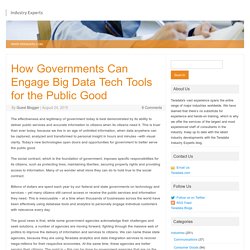
This is truer than ever today, because we live in an age of unlimited information, when data anywhere can be captured, analyzed and transformed to personal insight in hours and minutes –with visual clarity. 2003BIReport_v7. Gilt Groupe Speaks on Digital Marketing Optimization.